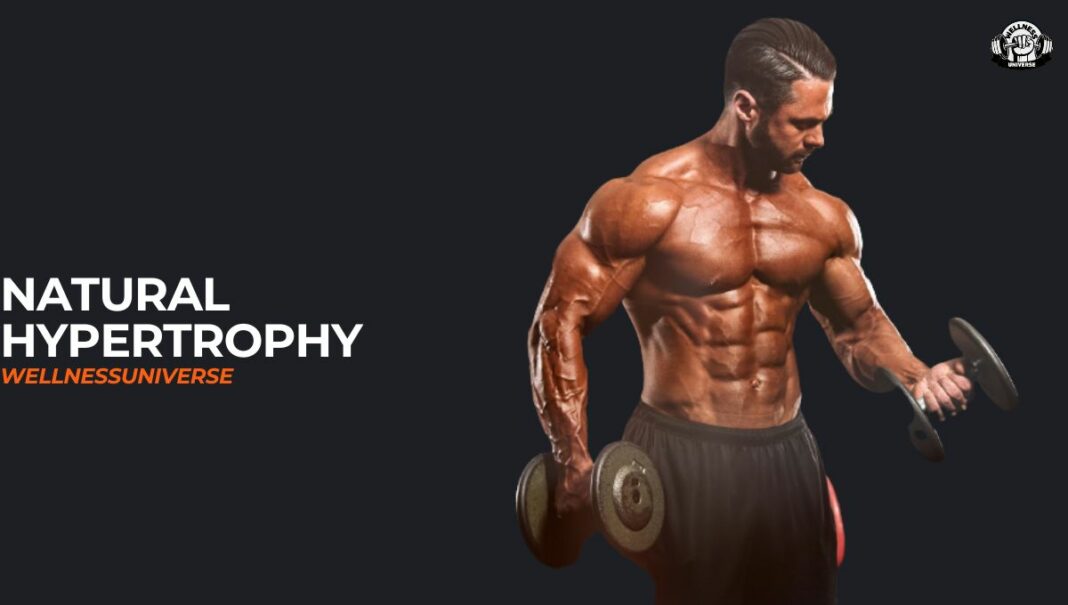Natural hypertrophy, in the context of fitness and bodybuilding, refers to the process of building muscle size and strength through natural means without the use of performance-enhancing substances such as anabolic steroids or synthetic hormones. It is a gradual and sustainable approach to muscle growth that relies on effective training, proper nutrition, and respecting the body’s natural limitations. Natural hypertrophy celebrates the body’s inherent ability to adapt and respond to training stimuli, leading to noticeable gains in muscle mass and improved athletic performance.
Natural muscle growth is of paramount importance in the fitness community, promoting overall health, well-being, and physical performance. Unlike unnatural methods that may yield rapid but risky results, natural hypertrophy fosters a balanced and sustainable approach to fitness. Embracing natural muscle building not only ensures safety and longevity but also reinforces the idea that fitness is a journey to be enjoyed, leading to a healthier lifestyle.
Throughout this comprehensive blog, we will delve deep into the world of natural hypertrophy and explore the science, principles, and practices that contribute to genuine muscle growth. We will shed light on how natural hypertrophy differs from other muscle growth methods, dispelling common misconceptions along the way. Understanding the factors that influence natural muscle building, including genetics and progressive overload, will be pivotal to unlocking your full potential.
The significance of nutrition in supporting muscle growth will be explored, as we outline the optimal macronutrient ratios and essential micronutrients necessary for successful natural hypertrophy. We will discuss the role of proper supplementation and nutritional strategies tailored to maximize your results.
Embarking on the journey to natural hypertrophy can be both exciting and challenging. In this blog, we will guide you through setting realistic expectations, measuring progress, and maintaining motivation. You will gain insight into age-appropriate training and how to avoid common pitfalls, such as overtraining, ensuring your efforts are efficient and injury-free.
Moreover, we will emphasize the importance of adopting a sustainable fitness lifestyle and long-term approach to natural muscle growth. By focusing on training principles, periodization, and tracking progress, you will be equipped with the knowledge and tools to make lasting strides in your fitness journey.
Embrace the power of natural hypertrophy as we unravel the secrets and demystify the science behind sustainable muscle growth. This blog aims to empower you with valuable insights, actionable strategies, and the motivation to sculpt a stronger, healthier, and more confident you. Let’s embark on this transformative journey together!
Understanding Natural Hypertrophy

Natural hypertrophy stands in stark contrast to other muscle growth methods that involve the use of performance-enhancing substances, such as anabolic steroids or synthetic hormones. Unlike unnatural approaches, which may offer rapid and exaggerated results, natural hypertrophy is a gradual and sustainable process. It revolves around harnessing the body’s inherent ability to adapt and grow through effective training and nutrition. By opting for natural muscle building, fitness enthusiasts prioritize health, longevity, and overall well-being, appreciating the journey as much as the destination.
There are prevalent myths and misconceptions surrounding unnatural muscle growth methods. Many individuals might be tempted by the allure of shortcuts and rapid transformations but are often unaware of the potential health risks and adverse effects associated with these substances. By dispelling these myths, this section of the blog will highlight the importance of making informed decisions and choosing a safer and more sustainable path to achieving muscle growth and athletic performance.
Understanding the science behind natural muscle building requires a grasp of muscle fiber types and their role in hypertrophy. The two primary types of muscle fibers are slow-twitch (Type I) and fast-twitch (Type II). During natural hypertrophy, both types of muscle fibers can undergo hypertrophy, leading to increased muscle size and strength. Slow-twitch fibers are primarily involved in endurance activities and adapt by enhancing oxidative capacity. In contrast, fast-twitch fibers play a crucial role in high-intensity, explosive movements and respond to hypertrophy by increasing contractile proteins. By tailoring training methods to stimulate both fiber types effectively, individuals can optimize their natural muscle growth potential.
Hormonal and cellular factors play pivotal roles in natural muscle building. Hormones such as testosterone, growth hormone, and insulin-like growth factor-1 (IGF-1) significantly influence muscle growth and repair. Engaging in resistance training and other forms of exercise triggers anabolic responses that promote protein synthesis and muscle adaptation. Additionally, cellular signaling pathways, such as mTOR (mammalian target of rapamycin), are activated during natural hypertrophy, regulating cellular growth and protein synthesis. By understanding the interplay between hormones and cellular mechanisms, individuals can optimize their training and nutrition strategies to support natural muscle growth effectively.
As we explore the nuances of natural hypertrophy, it becomes evident that this approach prioritizes sustainable progress, overall health, and respect for the body’s innate capabilities. By embracing the science behind natural muscle building and debunking myths surrounding unnatural methods, fitness enthusiasts can make informed choices that lead to lasting results and a stronger, more resilient physique. In the subsequent sections, we will delve deeper into the key factors that contribute to natural hypertrophy, including genetics, progressive overload, and the crucial role of nutrition in supporting muscle growth.
Factors Influencing Natural Hypertrophy
Genetics plays a fundamental role in determining an individual’s potential for muscle growth. While everyone can benefit from natural hypertrophy, genetic variability means that responses to training and nutrition may differ among individuals. Some individuals may naturally possess a higher proportion of fast-twitch muscle fibers, making them more predisposed to explosive strength and muscle size. Others may have a greater response to certain hormones, facilitating easier muscle adaptation. Understanding genetic factors helps individuals set realistic expectations and embrace their unique potential for natural muscle building.
While genetics lay the foundation, they do not dictate the final outcome. By acknowledging genetic factors, fitness enthusiasts can strategically tailor their training and nutrition to optimize their muscle-building potential. Leveraging progressive overload and appropriate exercise selection becomes paramount in maximizing muscle gains. By focusing on effective training principles and targeted nutrition, individuals can achieve remarkable results within the scope of their genetic potential.
Progressive overload is the core principle of natural hypertrophy. It involves systematically increasing the demands placed on muscles over time to encourage growth and adaptation. As the body becomes accustomed to a specific workload, further challenges must be introduced to stimulate continuous muscle development. This can be achieved by increasing the resistance, volume, intensity, or frequency of workouts. By consistently pushing beyond previous limits, fitness enthusiasts can spark new muscle growth and achieve sustained progress.
Creating effective workout routines that incorporate progressive overload is essential for natural hypertrophy. Structured resistance training programs that include a variety of exercises targeting different muscle groups ensure balanced muscle development. Periodization, the strategic planning of training phases, allows for adequate recovery and prevents plateaus. Additionally, incorporating rest days and deload weeks helps the body recover and reduce the risk of overtraining, ensuring sustained progress over the long term.
Compound exercises, which engage multiple muscle groups simultaneously, form the foundation of effective natural muscle building. Exercises like squats, deadlifts, bench presses, and overhead presses recruit a large number of muscle fibers and elicit a robust hormonal response. They stimulate significant muscle stress and adaptation, leading to increased muscle mass and strength. Incorporating compound movements into training routines helps optimize natural hypertrophy and promotes functional strength applicable to daily activities.
Volume, frequency, and intensity are crucial factors to consider in designing a training program for natural muscle building. Volume refers to the total workload lifted during a session, while frequency indicates how often a specific muscle group is trained per week. The appropriate balance of volume and frequency ensures sufficient muscle stimulation without compromising recovery. Intensity, on the other hand, relates to the effort exerted during a workout and can be adjusted to challenge the muscles while avoiding injury.
By understanding and applying these key factors, individuals can embrace the principles that govern natural hypertrophy. Harnessing genetic potential, employing progressive overload, and implementing effective training principles will pave the way for steady and sustainable muscle growth. In the next section, we will delve into the significant role of nutrition in supporting natural muscle development and optimizing the results of your training efforts.
Nutrition for Natural Muscle Growth
Protein is the cornerstone of natural muscle growth as it provides the essential building blocks, amino acids, needed for muscle repair and synthesis. Consuming adequate protein supports the recovery process after workouts and promotes the development of new muscle tissue. The recommended daily protein intake for individuals aiming for hypertrophy generally ranges from 1.2 to 2.2 grams of protein per kilogram of body weight. Including quality protein sources such as lean meats, poultry, fish, dairy products, eggs, legumes, and plant-based protein alternatives is crucial to meeting these requirements.
While protein is vital, the right balance of macronutrients (protein, carbohydrates, and fats) is equally essential for effective natural muscle building. Carbohydrates serve as the primary energy source for high-intensity workouts and replenish glycogen stores in muscles. They are critical for optimal performance and recovery. Healthy fats play a role in hormone production, including testosterone, which contributes to muscle growth. A balanced diet that includes all three macronutrients in appropriate proportions ensures the body receives the necessary energy and nutrients to support muscle development.
Whether an individual should aim for a caloric surplus or maintenance largely depends on their specific muscle growth goals and metabolism. A caloric surplus, where the number of calories consumed exceeds the body’s energy expenditure, provides a surplus of energy that can be used for muscle repair and growth. This approach is especially beneficial for those looking to gain significant muscle mass. On the other hand, individuals aiming for lean gains or those concerned about minimizing fat gain might opt for maintenance calories. Calculating daily caloric needs based on activity levels and goals is essential for effective natural hypertrophy.
Balancing energy intake and expenditure is critical to achieving natural muscle growth while minimizing fat accumulation. Consuming excessive calories beyond the body’s needs may lead to unwanted fat gain, while inadequate calorie intake can hinder muscle development. Consistency in nutritional habits, along with adjustments based on progress, helps strike the right balance for sustained hypertrophy. Tracking caloric intake, meal planning, and monitoring body composition changes can aid in fine-tuning nutrition for optimal results.
In addition to macronutrients, micronutrients, such as vitamins and minerals, play crucial roles in supporting muscle health and overall performance. Vitamin D, for example, is essential for muscle function and calcium absorption, while vitamin C aids in collagen formation, promoting connective tissue health. Minerals like calcium, magnesium, and potassium contribute to muscle contractions and nerve function. A diet rich in fruits, vegetables, whole grains, and nuts provides a diverse array of micronutrients to support muscle growth and recovery.
While a well-balanced diet should be the primary source of nutrients, supplements can be beneficial for individuals struggling to meet specific nutritional requirements. Protein supplements, such as whey or plant-based protein powders, can help individuals meet their protein needs. Additionally, supplements like creatine and branched-chain amino acids (BCAAs) have been shown to support muscle growth and recovery. However, it’s crucial to use supplements judiciously and consult with a healthcare or nutrition professional before adding them to your regimen.
Understanding the importance of nutrition in natural muscle growth is integral to achieving optimal results from your training efforts. By prioritizing protein intake, balancing macronutrient ratios, and making informed decisions about caloric intake, individuals can support their bodies in reaching their hypertrophy goals. Incorporating a diverse range of micronutrients through whole foods and supplements, if necessary, ensures that the body is well-nourished to promote muscle health and overall well-being. In the next section, we will explore the significance of progressive overload and effective training principles in fostering natural hypertrophy.
Risks and Drawbacks of Unnatural Methods
Unnatural muscle growth methods, such as the use of anabolic steroids and synthetic hormones, can have severe repercussions on an individual’s health. Performance-enhancing substances work by artificially increasing muscle protein synthesis and testosterone levels, which leads to rapid muscle growth and improved athletic performance. However, these substances come with significant health risks, including liver damage, cardiovascular issues, hormonal imbalances, and psychological effects. The use of illegal and unauthorized substances exposes individuals to potential harm and is strictly prohibited in sports and fitness competitions.
The use of performance-enhancing substances raises ethical concerns, as it provides an unfair advantage over others who choose to pursue natural muscle growth. Athletes and fitness enthusiasts must abide by anti-doping regulations set by sports organizations to ensure fair competition. Moreover, the illegal acquisition and use of these substances can lead to legal consequences, tarnishing an individual’s reputation and career.
Engaging in unnatural hypertrophy can lead to a plethora of health risks and adverse side effects. Prolonged use of anabolic steroids can lead to cardiovascular complications, high blood pressure, liver and kidney damage, and gynecomastia (enlargement of breast tissue in males). Moreover, synthetic hormones can disrupt the body’s natural hormonal balance, leading to mood swings, irritability, and infertility in both men and women. The detrimental impact on the endocrine system can result in long-term health issues that may persist even after discontinuing the use of performance-enhancing substances.
The allure of rapid muscle growth and enhanced performance may tempt individuals to resort to unnatural methods. However, it is crucial to consider the long-term implications of these choices on overall health and well-being. While unnatural hypertrophy may yield short-term gains, it often comes at a significant cost to one’s health and quality of life. In contrast, natural hypertrophy prioritizes a sustainable and balanced approach to muscle growth, supporting overall health and fitness in the long run.
Understanding the risks and drawbacks associated with unnatural muscle growth methods is essential for making informed decisions about personal fitness journeys. Opting for natural hypertrophy not only promotes safer and more sustainable progress but also aligns with the principles of integrity and fair competition. Embracing the journey of natural muscle building encourages individuals to prioritize their health and well-being, fostering a positive and enriching fitness experience. In the final section, we will recap the significance of natural hypertrophy and provide encouragement to unlock one’s full potential through a balanced and wholesome approach to fitness.
In Crux
In conclusion, the journey of natural hypertrophy represents a powerful and transformative approach to muscle building and fitness. By understanding the principles, science, and factors that influence natural muscle growth, individuals can unlock their full potential in a sustainable and wholesome manner. Natural hypertrophy celebrates the body’s ability to adapt, grow, and perform at its best without the use of performance-enhancing substances.
Sustainable muscle building through natural hypertrophy not only leads to tangible physical changes but also fosters a positive mindset and an appreciation for the process of growth and self-improvement. By prioritizing progressive overload, training principles, and nutrition, individuals can set the foundation for long-lasting muscle development and improved athletic performance.
The risks and drawbacks of unnatural methods serve as a stark reminder of the importance of making health-conscious choices and adhering to ethical standards in fitness pursuits. Natural hypertrophy represents a path that embraces the journey as much as the destination, creating a healthier and more balanced lifestyle.
As you continue your fitness journey, remember that patience, consistency, and perseverance are key to achieving your goals. Celebrate every milestone, no matter how small, and stay committed to a training regimen and nutrition plan that aligns with your personal values and aspirations.
Embrace the challenges and relish the victories, for each step forward is a testament to your dedication and determination. Natural hypertrophy empowers you to sculpt not only your physique but also your character and resilience. As you unleash the power of natural muscle growth, may you find fulfillment in the process, and may it inspire you to discover the best version of yourself.
In the pursuit of natural hypertrophy, you have the opportunity to not only build muscle but also build a foundation for a healthier and more fulfilling life. With knowledge, discipline, and passion, you are well-equipped to embrace the transformative journey of sustainable muscle building. So, seize this opportunity, and let your commitment to natural hypertrophy be a testament to your unwavering dedication to self-improvement and well-being.
Remember, your body is a remarkable vessel capable of extraordinary feats. Treat it with kindness, respect, and gratitude, and it will reward you with strength, vitality, and a sense of accomplishment like never before. As you embark on this empowering journey, may the pursuit of natural hypertrophy guide you to newfound levels of fitness, confidence, and an enduring love for the beauty of the human body in its most natural and awe-inspiring form.
Thank you for joining us on this fitness journey! We hope you found our Muscle Growth Unleashed: Mastering Natural Hypertrophy blog insightful and inspiring. Our aim is to provide you with valuable information, expert advice, and motivational content to support you in your wellness endeavors.
Related Post :-
- How To Do Wall Pushups
- Batman Workout
- BMI Breakthrough
- Chin-Ups Unveiled
- Better Health
- Dips Unleashed
FAQs about Natural Hypertrophy
Can anyone achieve natural hypertrophy without using performance-enhancing substances?
Yes, anyone can achieve natural hypertrophy without the use of performance-enhancing substances. Natural hypertrophy relies on principles such as progressive overload, proper nutrition, and adequate rest. These factors stimulate muscle growth and optimize an individual's potential for muscle development. While genetics play a role in an individual's response to training, everyone has the capacity to enhance their muscle size and strength through natural means.
How long does it take to see significant results from natural hypertrophy?
The timeline for significant results in natural hypertrophy varies from person to person and depends on factors such as training intensity, nutrition, and individual response to exercise. Generally, noticeable improvements in muscle size and strength can be observed within a few months of consistent and dedicated training. However, it's essential to remember that muscle growth is a gradual process, and long-term commitment is necessary to achieve substantial and sustainable results.
Is natural hypertrophy limited by age or training experience?
Natural hypertrophy is not limited by age or training experience. While muscle growth might be faster in younger individuals due to higher levels of natural hormones, older individuals can still achieve considerable muscle gains through proper training and nutrition. Additionally, beginners and experienced athletes alike can benefit from natural hypertrophy principles to optimize their muscle development.
How can I avoid overtraining while pursuing natural hypertrophy?
To avoid overtraining during natural hypertrophy, it is crucial to implement proper rest and recovery strategies. Adequate sleep, rest days between intense workouts, and proper nutrition are essential for muscle repair and growth. Pay attention to your body's signals and adjust your training intensity and volume accordingly. Incorporate deload weeks into your training program to give your body a chance to recover fully and prevent burnout.
Can I achieve natural hypertrophy without resistance training?
Resistance training is a fundamental component of natural hypertrophy as it stimulates muscle growth and adaptation. While other forms of exercise, such as cardiovascular activities, are beneficial for overall health, resistance training is the most effective way to promote muscle hypertrophy. Engaging in a structured resistance training program that targets major muscle groups and includes progressive overload is essential for achieving natural hypertrophy.
Are there any specific nutritional supplements that support natural hypertrophy?
While the primary focus should be on obtaining nutrients from whole foods, some supplements can support natural hypertrophy. Protein supplements, such as whey or plant-based protein powders, can help individuals meet their daily protein needs. Creatine is a well-researched supplement that has been shown to enhance muscle performance and growth. Branched-chain amino acids (BCAAs) can also aid in muscle recovery and protein synthesis. However, supplements should be used wisely, and it is essential to consult with a healthcare or nutrition professional before adding them to your regimen.
Does natural hypertrophy lead to bulkiness in women?
Natural hypertrophy in women does not necessarily lead to excessive bulkiness. Women have lower levels of testosterone than men, which limits the potential for significant muscle mass gains. Instead, natural hypertrophy in women typically results in a toned and athletic physique. Engaging in resistance training can help women achieve lean muscle development, improved strength, and enhanced overall fitness without appearing overly bulky.
Can I lose the muscle gained during natural hypertrophy if I stop training?
If you stop training altogether, you may experience some muscle atrophy (decrease in muscle size). However, the muscle gained during natural hypertrophy can be maintained with consistent physical activity and proper nutrition. Regular engagement in resistance training and a balanced diet will help preserve muscle mass even if you reduce the frequency or intensity of your workouts.
How does natural hypertrophy impact overall health and well-being?
Natural hypertrophy positively impacts overall health and well-being. Engaging in regular physical activity and following a balanced nutrition plan not only promotes muscle growth but also contributes to better cardiovascular health, improved metabolic function, and enhanced mental well-being. Additionally, natural hypertrophy fosters a sense of accomplishment, discipline, and self-confidence that transcends beyond physical appearance, leading to a more fulfilling and active lifestyle.

Meet Pradeep Singh, your go-to guide for all things fitness, health, and motivation. With over 7 years in the field, Pradeep brings a blend of expertise and real-world experience to his writing. From workout tips to healthy living insights, he simplifies complex topics, making fitness accessible for everyone. His authentic approach and genuine passion aim to inspire and support your wellness journey. Get ready to embark on a path to a healthier lifestyle with Pradeep as your trusted companion and motivator.






















